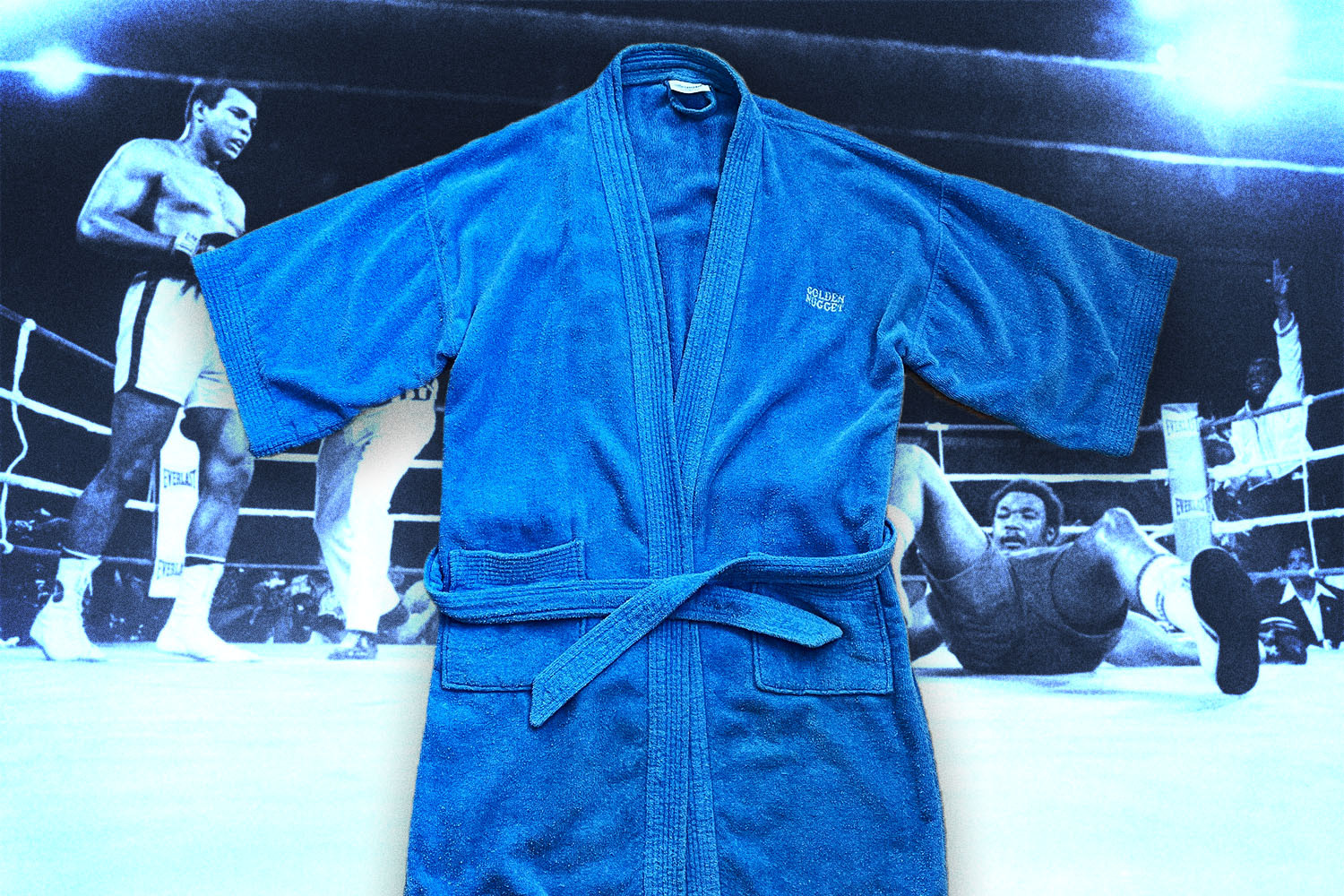In 2017 I visited my grandparents’ Sarasota condo for the first time since my grandfather’s passing the year before. My grandmother — always referred to as “Mam Mam,” which I think is Welsh — was anxious to pass on the clothing that had belonged to my “Dziadze,” which is the torturously spelled Polish word for grandfather.
Mixed among the many sizes-too-big-for-me Allen Edmonds and company windbreakers in his closet was an enormous, blue terry-and-velour bath robe embroidered with the name of the Golden Nugget casino on the left side of the chest. Naturally, it was the one thing I took.
Several days later, my dad called. He’d just spoken with my Mam Mam, who’d called to say what she’d forgotten at the time of our visit but now remembered: the robe had originally belonged to Muhammad Ali.
The story, as recounted to me, was that Ali had been in Atlantic City to see a fight. To guard his privacy, the retired fighter stayed at my grandparents’ two-bedroom condo on the 24th floor of the Ocean Club, which was otherwise unoccupied for the evening. As a show of thanks, he left behind a signed portrait book and his bath robe.
It was, for certain, an improbable sounding story with the structure of a fairy tale: an old couple gives shelter to a traveling stranger, who repays their kindness with unexpected gifts. But I knew there were family connections to the boxer. My Dziadze had known Ali’s business manager and all-around “facilitator” Gene Kilroy from a young age, having grown up in the same small Pennsylvania county. And I’d seen a photo dated to 1972 that showed Ali at his Deer Lake training camp flanked by my grandparents, my school-aged father and his two brothers.
In sum, there seemed to be enough circumstantial evidence to hang the robe from a place of honor behind my bathroom door, displayed like a terry-velour reliquary that connected myself and my family — however tenuously — to The Greatest. Still, I sometimes had doubts.
I didn’t believe that the story was fabricated, but I feared that with time, some of its details might have been misremembered. It seemed possible that Ali had indeed stayed over and left an autographed book behind, but that the robe — an admittedly weird memento — belonged solely to my Dziadze all along and had been lumped in with Ali’s gifts in the retelling.
In September my Mam Mam’s health declined sharply just weeks before her 90th birthday, and I returned to Pennsylvania to say goodbye. Sitting in her room at the assisted living facility, I asked her to tell the story one more time: perhaps there was some new nugget of information that could verify the robe’s origins once and for all. But on this account, I was too late: she had forgotten the episode entirely.
However, I learned that Gene Kilroy was still living. In the story’s telling, it had been Kilroy who had arranged Ali’s stay at the condo. If anyone could put the matter to rest, it was him.
After a cold email and an introduction from a family contact, I got on the phone with Kilroy. I recounted the story exactly as it had been told to me and expressed my eagerness to verify the robe’s original ownership.
“Well why would she lie to you?” he chided me, after confirming the story’s details. He added that he and Ali had wanted to avoid the public attention of a hotel stay and that it was my Dziadze who had extended the invitation. Kilroy was unsure of the exact date but believed it had been during the ‘80s.
Six days later my Mam Mam died, having just made 90. In the days after, my uncle located the signed books: as it turned out, there were two of them. In Ali’s first attempt at inscribing his portrait, his Parkinson’s had resulted in several crossed-out words. His inscription in the second book is much clearer, a simple “To Teddy, thank you,” followed by his signature and a date: January 22nd, 1988 — the night Mike Tyson fought Larry Holmes at the Trump Plaza.
Though I have to strain to decipher the fighter’s unsteady script in his original inscription, I much prefer it: “To all the Twardziks: Kindness to others is the only rent we pay for room on earth.”
To know your grandparents is a great blessing. But it comes coupled to the peculiar sadness of realizing you know only the final, sunset years, with a whole lifetime of experiences — like one of the greatest athletes of the 20th century crashing at your condo — submerged from view, like the greater part of an iceberg.
However, certain artifacts can provide a glimpse into all the living that came before. One hangs now from a peg on my bathroom door, and it even warms my own shoulders once in a while.
Whether you’re looking to get into shape, or just get out of a funk, The Charge has got you covered. Sign up for our new wellness newsletter today.
